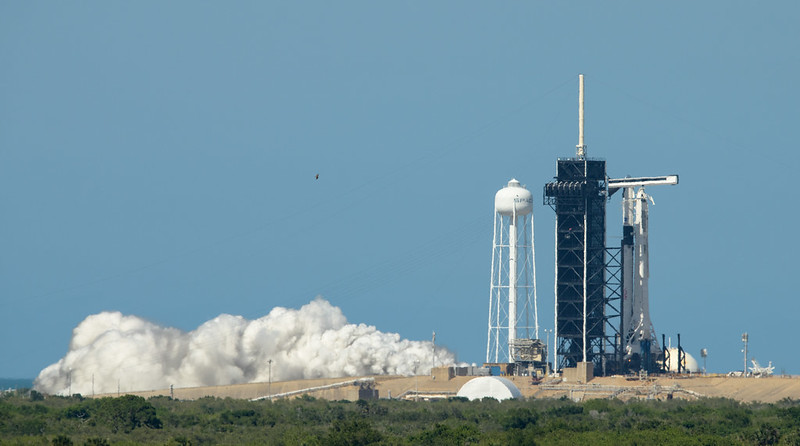SpaceX test-fires rocket for epic astronaut launch for NASA on May 27

SpaceX just notched another milestone on the path to its first-ever crewed launch next week.
Elon Musk's company is gearing up for the Wednesday (May 27) launch of the Demo-2 mission, which will send NASA astronauts Bob Behnken and Doug Hurley to the International Space Station (ISS) aboard a SpaceX Crew Dragon capsule.
This afternoon (May 22), the company performed a "static fire" test of the Falcon 9 rocket that will launch Demo-2, firing up the booster's first-stage engines briefly on the pad at NASA's Kennedy Space Center in Florida.
Related: SpaceX's historic Demo-2 Crew Dragon astronaut flight: Full coverage
The static fire occurred just a few hours after NASA, ISS and SpaceX teams wrapped up a critical, two-day flight readiness review (FRR), which declared Demo-2 clear for its planned May 27 liftoff.
There are still a few boxes to check over the next few days, however. On Saturday (May 23), for example, mission teams will run through a "dry dress" exercise, which will simulate many of the activities that NASA and SpaceX will perform in the leadup to launch on Wednesday. Behnken and Hurley will suit up for the dry dress, agency officials said.
And on Monday (May 25) comes the final launch readiness review, which will incorporate analyses of the data from the static fire and the dry dress along with other information, NASA officials said.
Breaking space news, the latest updates on rocket launches, skywatching events and more!
Demo-2 is designed to fully validate Crew Dragon and Falcon 9 for crewed flight, clearing the way for operational astronaut-carrying missions. SpaceX holds a contract with NASA's Commercial Crew Program to conduct six such flights (as does Boeing, which is developing a capsule called CST-100 Starliner).
Crew Dragon has reached the ISS once before, on the uncrewed Demo-1 mission in March 2019. But Demo-2 will be the first orbital human mission to launch from the United States since the final flight of NASA's space shuttle program in July 2011. Since then, the space agency has relied on Russian Soyuz rockets and spacecraft to get its astronauts to and from the ISS.
- SpaceX's Crew Dragon space capsule explained (infographic)
- In photos: SpaceX's historic Demo-2 test flight with astronauts
- See the evolution of SpaceX's rockets in pictures
Mike Wall is the author of "Out There" (Grand Central Publishing, 2018; illustrated by Karl Tate), a book about the search for alien life. Follow him on Twitter @michaeldwall. Follow us on Twitter @Spacedotcom or Facebook.
OFFER: Save 45% on 'All About Space' 'How it Works' and 'All About History'!
For a limited time, you can take out a digital subscription to any of our best-selling science magazines for just $2.38 per month, or 45% off the standard price for the first three months.

Michael Wall is a Senior Space Writer with Space.com and joined the team in 2010. He primarily covers exoplanets, spaceflight and military space, but has been known to dabble in the space art beat. His book about the search for alien life, "Out There," was published on Nov. 13, 2018. Before becoming a science writer, Michael worked as a herpetologist and wildlife biologist. He has a Ph.D. in evolutionary biology from the University of Sydney, Australia, a bachelor's degree from the University of Arizona, and a graduate certificate in science writing from the University of California, Santa Cruz. To find out what his latest project is, you can follow Michael on Twitter.

